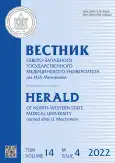Anemia of inflammation is a predictor of the progression of postoperative infection in obstetrics
- 作者: Korobkov N.A.1,2, Bakulina N.V.1, Lodyagina N.S.2
-
隶属关系:
- North-Western State Medical University named after I.I. Mechnikov
- Multiprofile Clinic Sestroretskaya
- 期: 卷 14, 编号 4 (2022)
- 页面: 53-61
- 栏目: Original study article
- URL: https://journals.rcsi.science/vszgmu/article/view/131113
- DOI: https://doi.org/10.17816/mechnikov114844
- ID: 131113
如何引用文章
详细
BACKGROUND: There is an insufficient number of studies studying the association of postpartum infectious and inflammatory complications with anemia of inflammation, which undoubtedly contributes to the risk of postpartum infection and the severity of its course.
AIM: To assess the prevalence of anemia of inflammation in pregnant women, to determine its prognostic value as an independent predictor of the progression of endometritis after caesarean section.
MATERIALS AND METHODS: A retrospective study of case histories and data from primary medical records of 648 puerperas delivered by caesarean section has been carried out. 406 of the patients have been diagnosed with endometritis after caesarean section and 242 — with a physiological course of the postoperative period. Anemia during pregnancy has been diagnosed with a decrease in hemoglobin <110 g/l (in the first trimester) and <105 g/l (in the second and third trimesters). Primary iron deficiency was determined by the level of serum ferritin. Anemia of inflammation has been diagnosed after exclusion of iron deficiency in the presence of documented signs of an inflammatory process (chronic diseases) and in accordance with the international hematological criteria: normochromic normocytic anemia, normo-/hyperferritinemia (serum ferritin >30 μg/l), hypotransferrinemia (transferrin <2 g/l) and the level of C-reactive protein in the blood (> 6 mg/l).
RESULTS: Anemia of inflammation can be attributed to the most significant predictors of the development of endometritis. The odds ratio for this factor was 4.12 (95% confidence interval 1.28–6.19; p < 0.001). The study has also shown that significant factors in the development of endometritis after caesarean section are obesity (odds ratio 3.45; 95% confidence interval 1.14–5.11; p = 0.005), asymptomatic bacteriuria (odds ratio 3.68; 95% confidence interval 1.31–4.94; p < 0.001), carbohydrate metabolism disorders (odds ratio 2.84; 95% confidence interval 1.54–3.52; p = 0.012) and arterial hypertension (odds ratio 2.14; 95% confidence interval 1.12–4.04; p = 0.032).
CONCLUSIONS: The prevalence of anemia of inflammation in pregnancy is 2.1%. Anemia of inflammation complicates the course of pregnancy 5.5 times more often in puerperas with endometritis after caesarean section (27.4 vs. 4.9%; χ2 = 52.1; p < 0.001), which makes it possible to classify it as a significant predictor of the development of postoperative infectious and inflammatory complications.
作者简介
Nikolai Korobkov
North-Western State Medical University named after I.I. Mechnikov; Multiprofile Clinic Sestroretskaya
编辑信件的主要联系方式.
Email: nikolai_korobkov@mail.ru
ORCID iD: 0000-0001-7279-2535
SPIN 代码: 4191-3581
MD, Cand. Sci. (Med.)
俄罗斯联邦, Saint Petersburg; Saint PetersburgNatalia Bakulina
North-Western State Medical University named after I.I. Mechnikov
Email: natalya.bakulina@szgmu.ru
ORCID iD: 0000-0003-4075-4096
SPIN 代码: 9503-8950
Scopus 作者 ID: 7201739080
Researcher ID: N-7299-2014
MD, Dr. Sci. (Med.), Assistant Professor
俄罗斯联邦, Saint PetersburgNatalia Lodyagina
Multiprofile Clinic Sestroretskaya
Email: fedorcka@mail.ru
MD, Cand. Sci. (Med.)
俄罗斯联邦, Saint Petersburg参考
- Hanson M, Bardsley A, De-Regil LM, et al. The International Federation of Gynecology and Obstetrics (FIGO) recommendations on adolescent, preconception, and maternal nutrition: “Think Nutrition First”. Int J Gynaecol Obstet. 2015;131 Suppl 4:S213–S253. doi: 10.1016/S0020-7292(15)30034-5
- van den Broek NR, Letsky EA. Etiology of anemia in pregnancy in south Malawi. Am J Clin Nutr. 2000;72(1 Suppl):247S–256S. doi: 10.1093/ajcn/72.1.247S
- Abioye AI, Park S, Ripp K, et al. Anemia of inflammation during human pregnancy does not affect newborn iron endowment. J Nutr. 2018;148(3):427–436. doi: 10.1093/jn/nxx052
- Lanser L, Fuchs D, Kurz K, Weiss GL. Physiology and inflammation driven pathophysiology of iron homeostasis — mechanistic insights into anemia of inflammation and its treatment. Nutrients. 2021;13(11):3732. doi: 10.3390/nu13113732
- Fishbane S, Mathew A, Vaziri ND. Iron toxicity: Relevance for dialysis patients. Nephrol Dial Transplant. 2014;29:255–259. doi: 10.1093/ndt/gft269
- Kaushansky K, Lichtman M, Prchal J, et al. Williams, Manual de Hematología. 9 Edición. Editorial MC Graw-Hill; 2016.
- Libregts SF, Gutiérrez L, de Bruin AM, et al. Chronic IFN-γ production in mice induces anemia by reducing erythrocyte life span and inhibiting erythropoiesis through an IRF-1/PU.1 axis. Blood. 2011;118(9):2578–2588. doi: 10.1182/blood-2010-10-315218
- Kassebaum NJ, Jasrasaria R, Naghavi M, et al. A systematic analysis of global anemia burden from 1990 to 2010. Blood. 2014;123(5):615–624. doi: 10.1182/blood-2013-06-508325
- Nemeth E, Rivera S, Gabayan V, et al. IL-6 mediates hypoferremia of inflammation by inducing the synthesis of the iron regulatory hormone hepcidin. J Clin Invest. 2004;113(9):1271–1276. doi: 10.1172/JCI20945
- Nemeth E, Valore EV, Territo M, et al. Hepcidin, a putative mediator of anemia of inflammation, is a type II acute-phase protein. Blood. 2003;101(7):2461–2463. doi: 10.1182/blood-2002-10-3235
- Fisher AL, Nemeth E. Iron homeostasis during pregnancy. Am J Clin Nutr. 2017;106(Suppl 6):1567S–1574S. doi: 10.3945/ajcn.117.155812
- Adamyan LV, Artymuk NV, Belokrinitskaya TE, et al. Septicheskie oslozhneniya v akusherstve: klinicheskie rekomendatsii (protokol lecheniya). (Utverzhdeny Obshchestvom akusherskikh anesteziologov-reanimatologov i Rossiiskim obshchestvom akusherov-ginekologov 9, 10 yanvarya 2017 g.). Moscow; 2017. 63 p. (In Russ.)
- Normal’naya beremennost’: klinicheskie rekomendatsii (protokol lecheniya). Odobreno Nauchno-prakticheskim Sovetom Minzdrava RF. Moscow; 2020. 75 p. (In Russ.)
- Abioye AI, Aboud S, Premji Z, et al. Iron Supplementation affects hematologic biomarker concentrations and pregnancy outcomes among iron deficient Tanzanian women. J Nutr. 2016;146(6):1162–1171. doi: 10.3945/jn.115.225482
- Tussing-Humphreys L, Pustacioglu C, Nemeth E, Braunschweig C. Rethinking iron regulation and assessment in iron deficiency, anemia of chronic disease, and obesity: introducing hepcidin. J Acad Nutr Diet. 2012;112(3):391–400. doi: 10.1016/j.jada.2011.08.038
- Weiss G, Ganz T, Goodnough LT. Anemia of inflammation. Blood. 2019;133(1):40–50. doi: 10.1182/blood-2018-06-856500
补充文件







